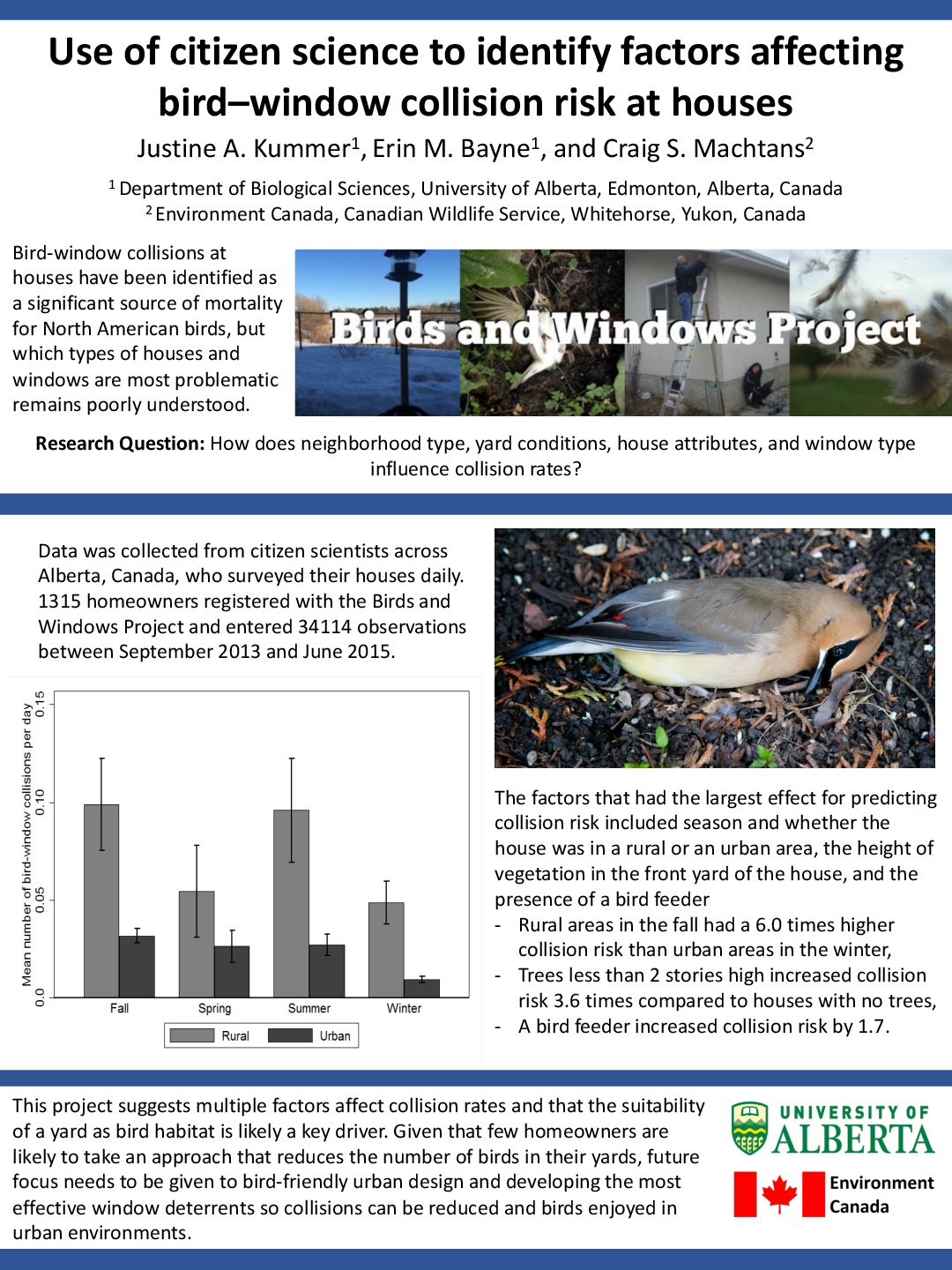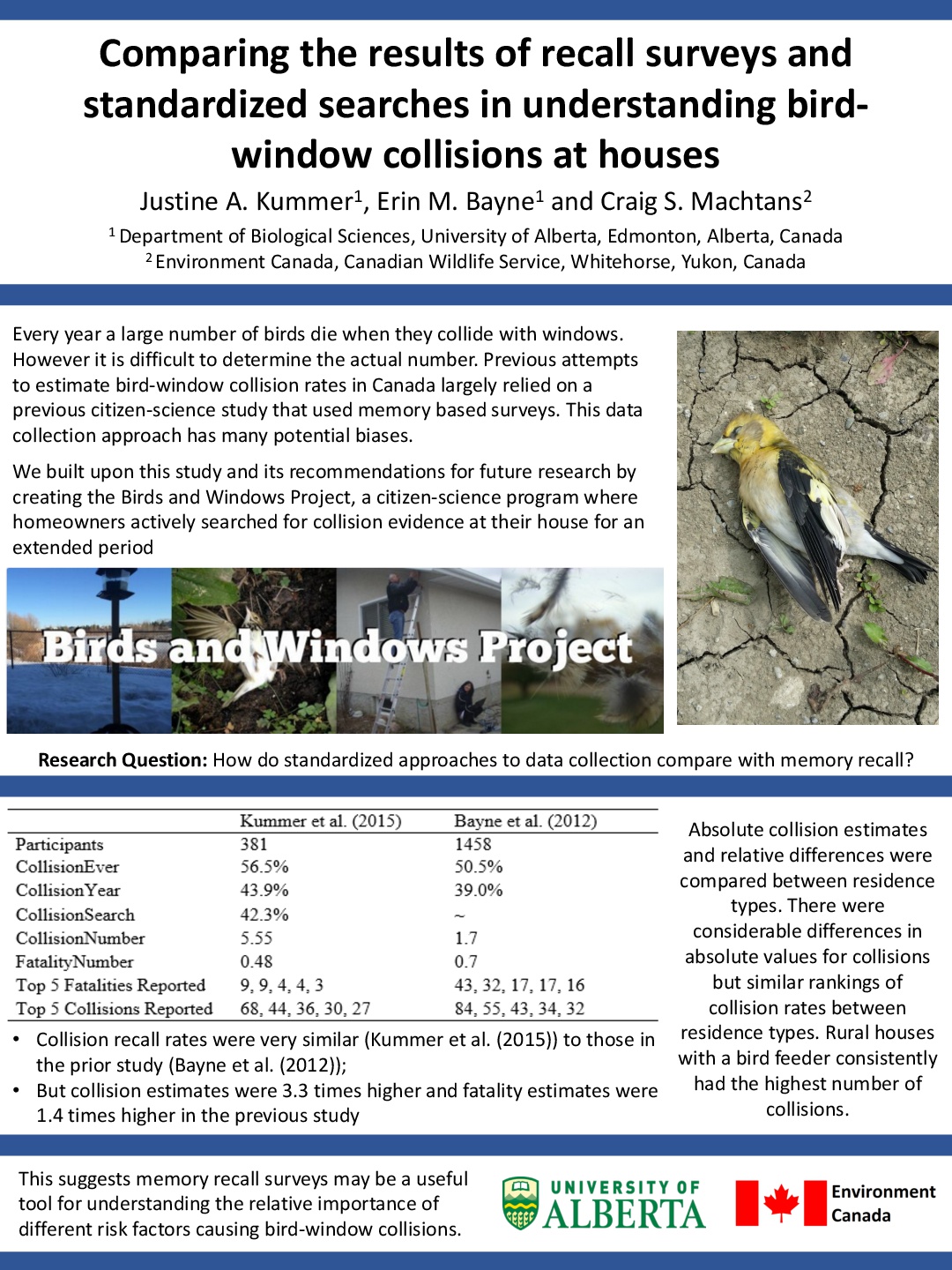Category Archives: Science
The use of citizen science to identify the factors affecting bird-window collisions at residential houses
Here’s the second post looking at the results of the Birds and Windows project! Here’s a link if you missed the first one. Today I’m focusing on the factors affecting collisions at residential houses.
In the past there have only been four studies looking at why one house has more collisions than another and each of these studies have focused on different aspects of window collision risk. These studies did not look at the impacts of multiple factors, including window type and yard attributes at the same time.
We propose the factors influencing bird-window collisions at houses be categorized based on scale into four levels: neighbourhood type, yard conditions, house attributes, and window types. Understanding the level that has the greatest impact on bird-window collision rates has implications for prioritizing mitigation options
The Birds and Windows citizen science project was developed to gain a better understanding of the factors affecting collisions at residential houses at all four levels with our main objective to focus on understanding the relative importance of variables at each of our four levels.
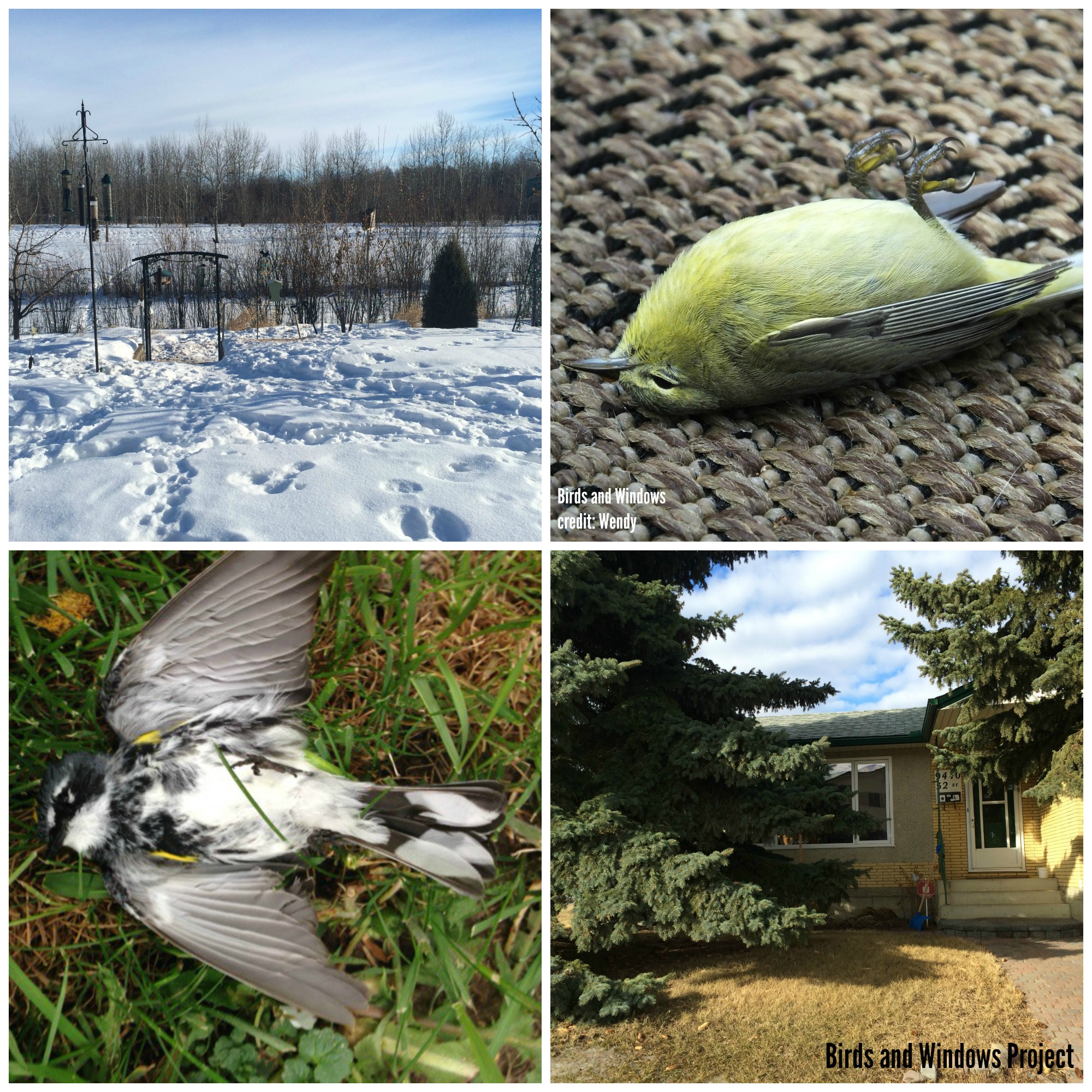
Since the launch of the Birds and Windows project there have been 34114 observations entered from homeowners in Alberta. Of these there were 930 collisions and 102 fatalities.
Of the collisions in Alberta, 497 could be identified to species or family. There were collisions from 53 different species. Birds that frequent feeders accounted for 295 of the identified collisions and 202 collisions were by those birds that do not visit feeders.
The most common species were Black-capped chickadees (n=50), American robins (n=40), Dark-eyed juncos (n=31), Bohemian waxwings (n=30), Cedar waxwings (n=24), and Black-billed magpies (n=22). There were a number of birds categorized as sparrows, chickadees, or waxwings which could not be identified further and as a result the numbers for Black-capped chickadees, House sparrows and both waxwing species are likely higher than reported above.
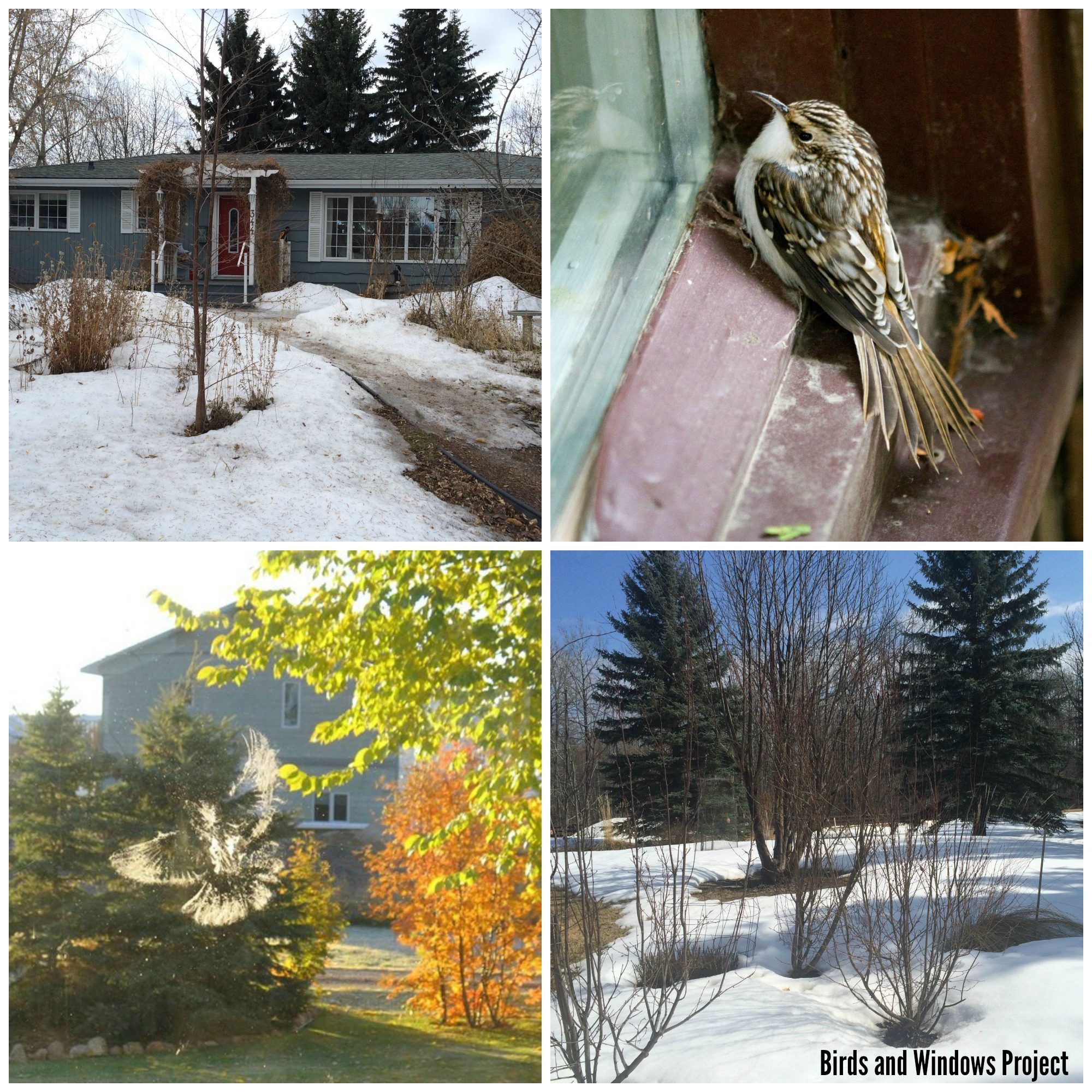
The factors identified at the yard level were the best explanation for the number of collisions. Those at the neighbourhood level were a close second.
Overall, the 3 factors identified as having the largest effect on bird-window collisions was whether the house was in an urban or rural location, the height of vegetation in the front yard of a house and whether or not there was a bird feeder present within 10 m of the house. There was additionally a large effect of seasonality on collision risk.
At the neighbourhood level there was a strong effect of both urban/rural location and season. Rural homes during the fall had a daily collision risk 10.84 times greater than urban houses in the winter. Those houses more likely to have a collisions where rural homes during spring and fall migration.
At the yard level the presence of a bird feeder, the height of vegetation in the front yard, whether the yard was considered developed or undeveloped and season had the largest effect on collision risk. Houses with a feeder in the fall had 5.96 times more collisions than a house without a feeder in the winter. Those houses more likely to have a collision were homes with a bird feeder, during spring and fall migration, houses with vegetation in the front yard 2 storeys or higher and houses in an undeveloped landscape.
At the house level the number of windows, the year the house was build, the building type and season had the strongest effect on collision risk. Those houses more likely to have a collision include houses with more than 10 windows, houses built before 1970, single-attached houses and during spring and fall migration.
At the window level whether or not vegetation was reflected in the window, the side of the house the window was on, the direction the window faced and the type of glass of the window were the best predictors of a collision. Those windows more likely to be a collision window include windows that reflect vegetation, windows on the front of a house, windows facing south and Low-E and UV glass windows. 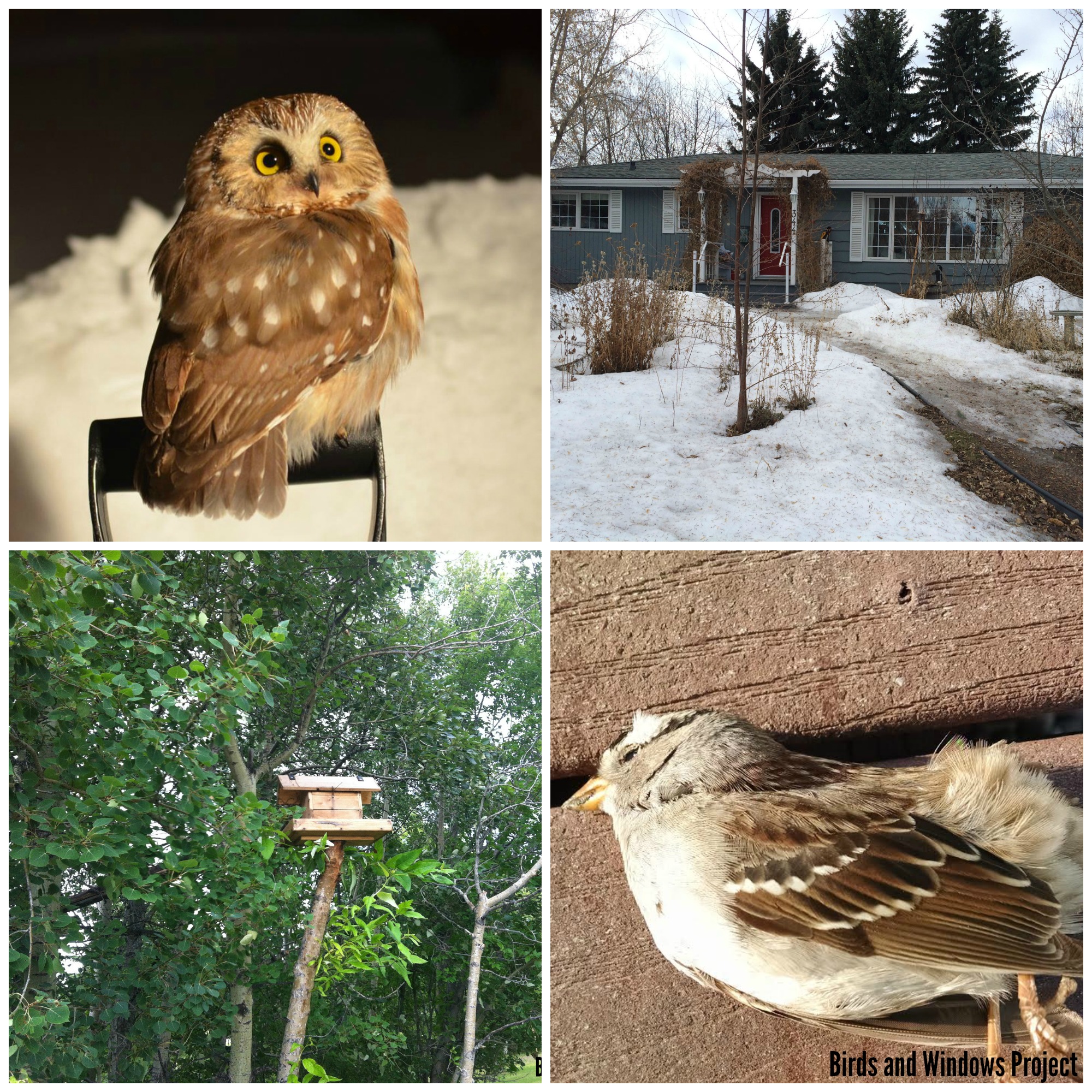
In looking at differences between those birds that visit feeders and those birds that do not, the presence of a bird feeder increased collision risk 6.13 times for feeder birds and 2.96 times for non-feeder birds. This suggests that similar factors are affecting both groups. As well, those homes with bird feeders are more likely to have urban gardens and have created bird-friendly regions at their homes which are attracting non-feeder birds.
These results are generally consistent with other studies which have focused on a handful of the factors we have outlined. Factors associated with vegetation and increasing bird abundance have the largest effect on collision risk. Reductions to vegetation cover and abundance might reduce collisions however homeowners are not likely wanting to reduce the vegetation and number of birds in their yard. Instead we suggest we shift our focus towards developing the most effective window deterrents.
Comparing different data collection methods in understanding bird-window collisions at residential houses
Here’s the first post discussing the results of my Birds and Windows project. Today I will focus on how the results from this study compare to the previous study conducted at the University of Alberta on bird-window collisions at houses.
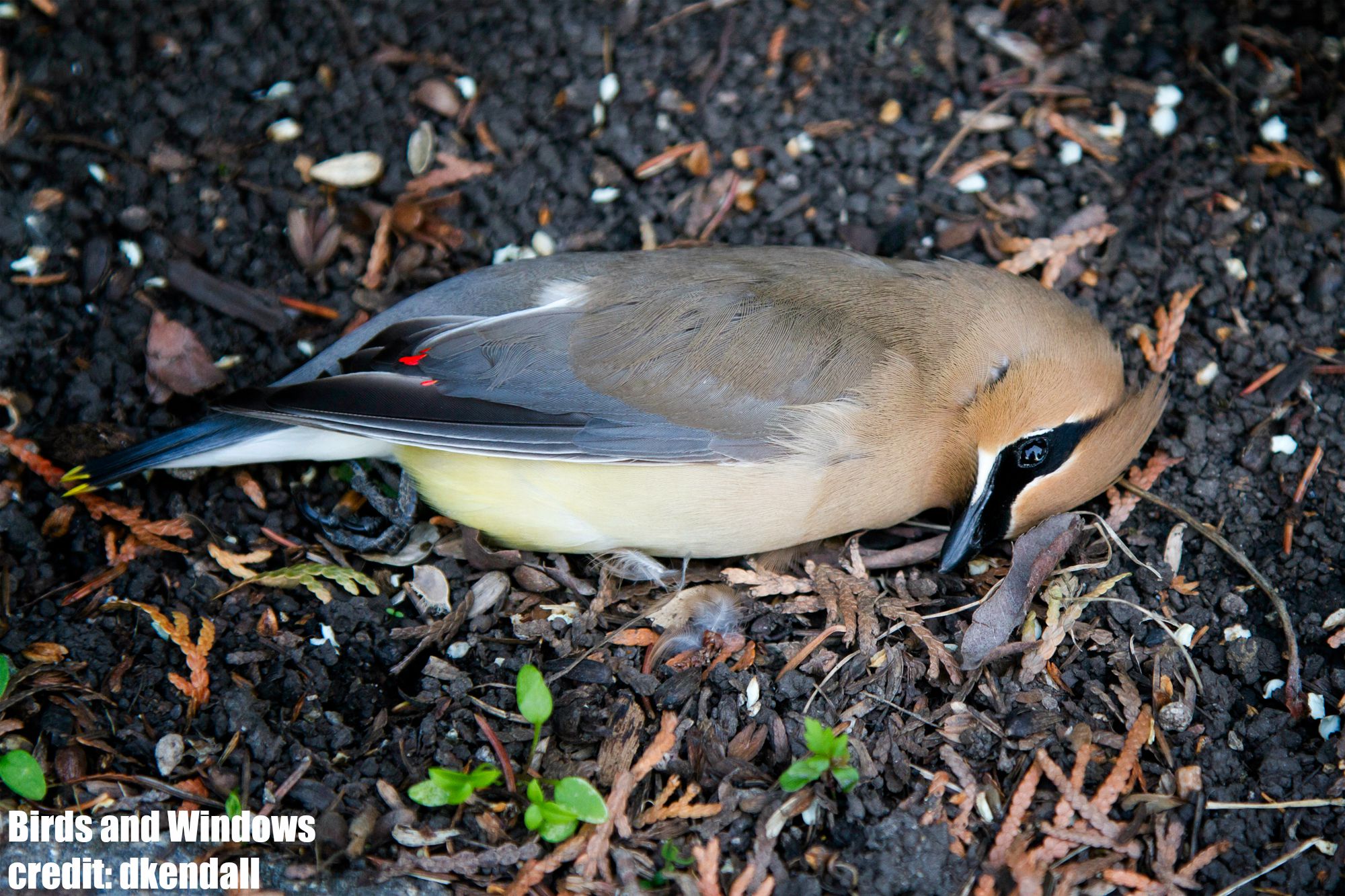 Every year a large number of birds die when they collide with windows. The actual number however is difficult to estimate. Previous attempts to estimate bird-window collision rates in Canada have relied heavily on a study where homeowners were asked to recall whether or not they could remembered a bird colliding with a window of their home in the past year. This was the first bird-window collision study to use citizen science, or members of the general public to conduct their research. However, this study relied entirely on memory and there were a number of potential issues.
Every year a large number of birds die when they collide with windows. The actual number however is difficult to estimate. Previous attempts to estimate bird-window collision rates in Canada have relied heavily on a study where homeowners were asked to recall whether or not they could remembered a bird colliding with a window of their home in the past year. This was the first bird-window collision study to use citizen science, or members of the general public to conduct their research. However, this study relied entirely on memory and there were a number of potential issues.
We built upon this study and their recommendations for future research by creating a citizen science project where homeowners reported on previous bird-window collisions at their home and then actively searched for collision evidence at houses and apartments for an extended period. The Birds and Windows project was born. Our main objective was to see how standardized approaches to data collection compared to memory recall.
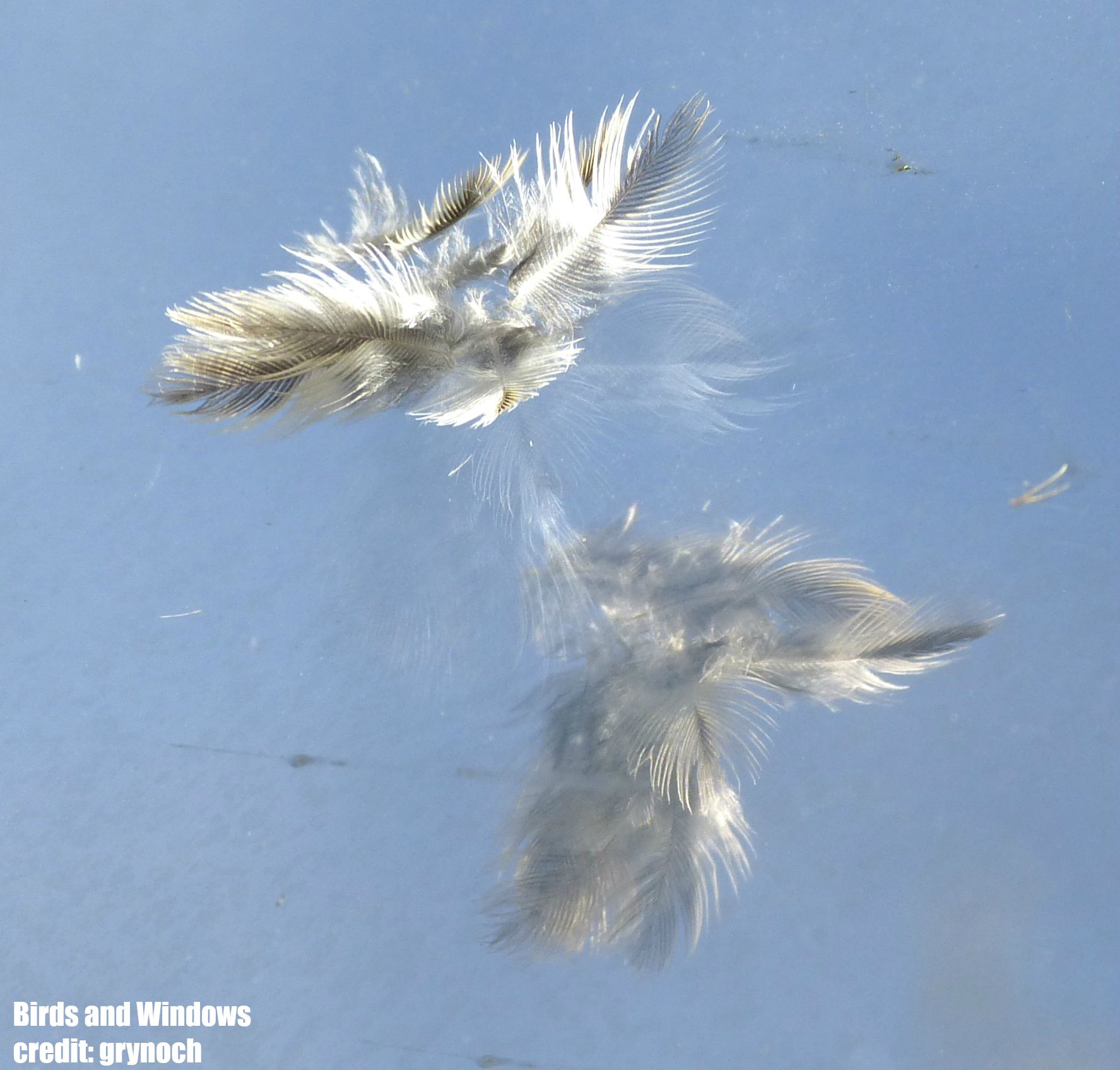 1315 participants registered with the project since September 2013. 93% of homeowners were from Canada but there were also a handful of participants from the United States, the United Kingdom and other various countries. Within Canada, 81% of homeowners were from Alberta.
1315 participants registered with the project since September 2013. 93% of homeowners were from Canada but there were also a handful of participants from the United States, the United Kingdom and other various countries. Within Canada, 81% of homeowners were from Alberta.
Based on homeowner searches rural residences with a feeder had a 91.7% probability of a collision occurring, this was greater than rural residences without a feeder (69.2%), urban residences with a feeder (50.5%), urban residences without a feeder (33.9%), and apartments (25.0%). The types of houses with the highest number of collisions were similar between all studies and methods.
 We compared absolute collision estimates as well as relative differences between residence types and found considerable differences in absolute values of collisions but similar rankings of collision rates between residence types. Collision rates based on memory recall in our study (56.5%) were very similar to the previous Bayne et al. (2012) study where 50.5% of participants remembered a bird colliding with a window at some time in the past. Fatality estimates however were 1.4 times higher in Bayne et al. (2012) than our study based on standardized searches however.
We compared absolute collision estimates as well as relative differences between residence types and found considerable differences in absolute values of collisions but similar rankings of collision rates between residence types. Collision rates based on memory recall in our study (56.5%) were very similar to the previous Bayne et al. (2012) study where 50.5% of participants remembered a bird colliding with a window at some time in the past. Fatality estimates however were 1.4 times higher in Bayne et al. (2012) than our study based on standardized searches however.
This suggests that memory recall-surveys may be a useful tool for understanding the relative importance of different risk factors causing bird-window collisions which is essential for creating effective mitigation strategies. Citizen scientists were essential in conducting this study and we argue that until there’s a more technological solution, citizen science is the most cost-effective option for achieving the sample sizes required in real-world scenarios. Shifting from estimating the magnitude of the problem to using citizen scientists to help solve the problem of bird-window collisions should become a focus of future research and conservation efforts.
Literature Cited
Bayne, E. M., C. A. Scobie, and M. Rawson-Clark. 2012. Factors influencing the annual risk of bird-window collisions at residential structures in Alberta, Canada. Wildlife Research 39:583-592.
New publication on bird feeders and bird-window collisions
Bird feeders and their effect on bird-window collisions
A few months ago I wrapped up my experiment looking at bird feeders and their effects on bird-window collisions. The data is now analyzed and the results all written up. Here’s what we learned:
In recent years many people have turned to bird feeding as a simple way to interact with nature. More and more people are living in cities than ever before and here interactions with wildlife are limited. Feeding wild birds has created this opportunity.This increase in bird feeders has created a new problem: collisions with buildings. The general public enjoys feeding the birds in their yard but they want to know how to do so safely.
This led to the development of the Birds and Windows Project: Bird Feeder Experiment. The project relied entirely on citizen science and the dedication of the 43 homeowners that were recruited within Edmonton, Alberta and the surrounding area.
The design of this experiment was quite simple. A bird feeder was present at 1 m, 5 m or absent from a study window for one month and then removed or added for the second month. The study was conducted over an entire year and the homeowner searched the study window for evidence of a bird-window collision every day of each trial. A total of 284 trials were completed at 55 windows.

Throughout the study there were 145 bird-window collisions. There were 51 collisions when there was no bird feeder present and this increased to 94 when a feeder was added in front of the window. The mean number of collisions was 0.64 per trial when the feeder was 1 m from the window and 0.72 when the feeder was 5 m from the window.
Comparing each window in its back-to-back trials (feeder vs. no feeder), we found 11 windows had a greater number of collisions when there was no feeder present while 16 windows had more collisions when there was a bird feeder present. 26 windows did not report any collisions at all, but the top 5 windows reported 24, 19, 15, 11 and 9 collisions while participating in the project.
Surprisingly, there was a lot of variation in the number of collisions when looking at the season the trial was conducted in. There was a mean of 0.11 collisions in the winter and this increased to 0.79 during spring migration, 0.54 in the summer breeding months, and 1.08 through fall migration.
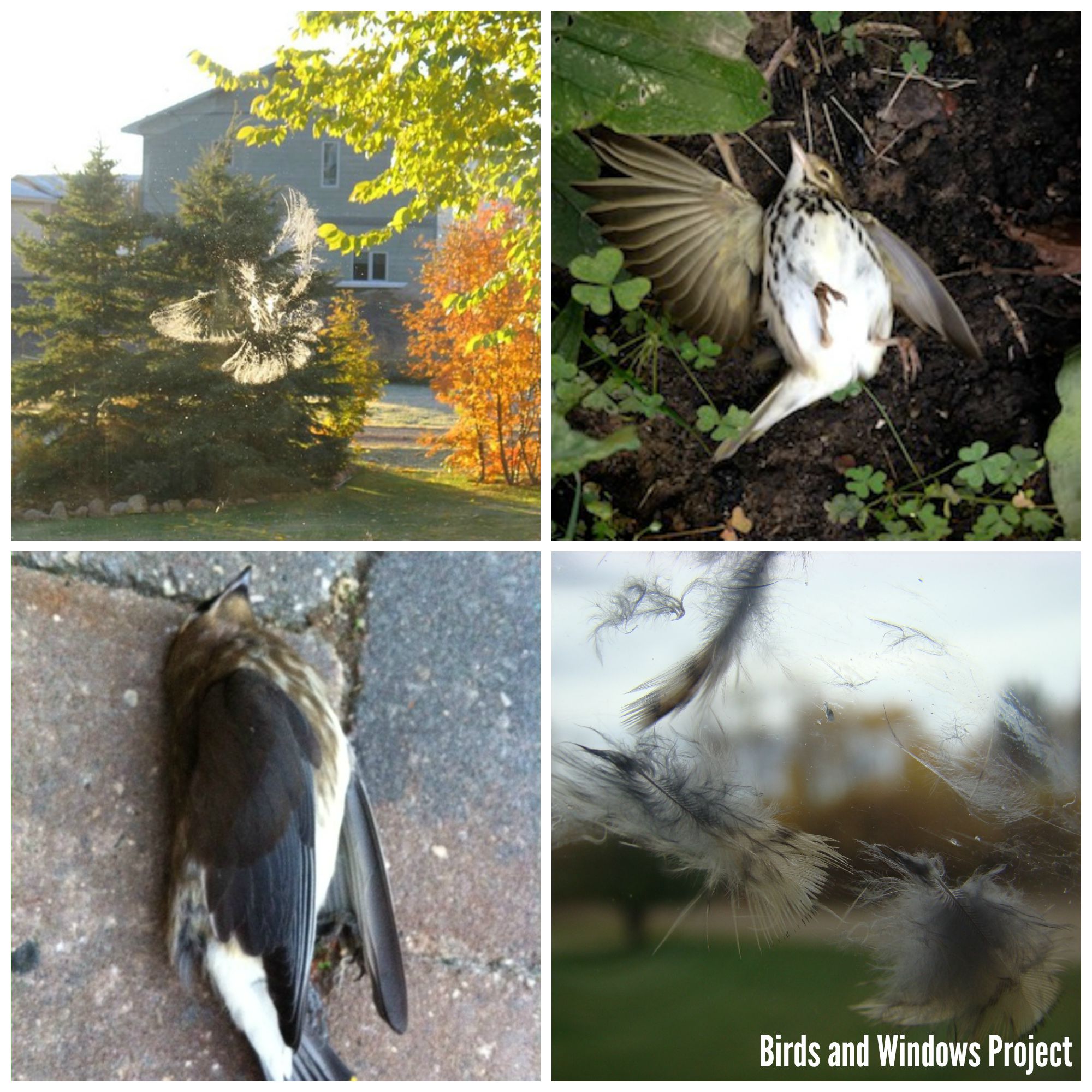
This study does support the results of previous studies. The highest mean number of collisions was seen when the bird feeder was the greatest distance from the window. However, there was a lot of variation between houses. This shows that the effect of a bird feeder is largely dependent on the individual home and window being evaluated.
Seasonality was seen to cause a lot of the observed variation in window collision rates. This wasn’t entirely surprising as more than 80% of the birds in Alberta are migratory. They’re just simply not as many birds present in the winter months to collide with windows.
Our results suggest that homeowners can reduce some window collision risk by altering feeder placement. However, this will likely not reduce collisions to zero, particularly at houses where collisions are common. Feeders are only one of many factors, including vegetation and house characteristics that influence whether a residence is likely to have a large number of collisions.
In conducting this study a number of participants provided updates on the activity at their bird feeder and at the end of the project a handful kept their feeder. Homeowners enjoy having birds in their yards and being able to feed them. Feeding wild birds creates an important link between the general public and nature and improving this relationship will continue to promote biodiversity and conservation. Finding successful ways for them to do so could be beneficial to both birds and the millions who feed them.
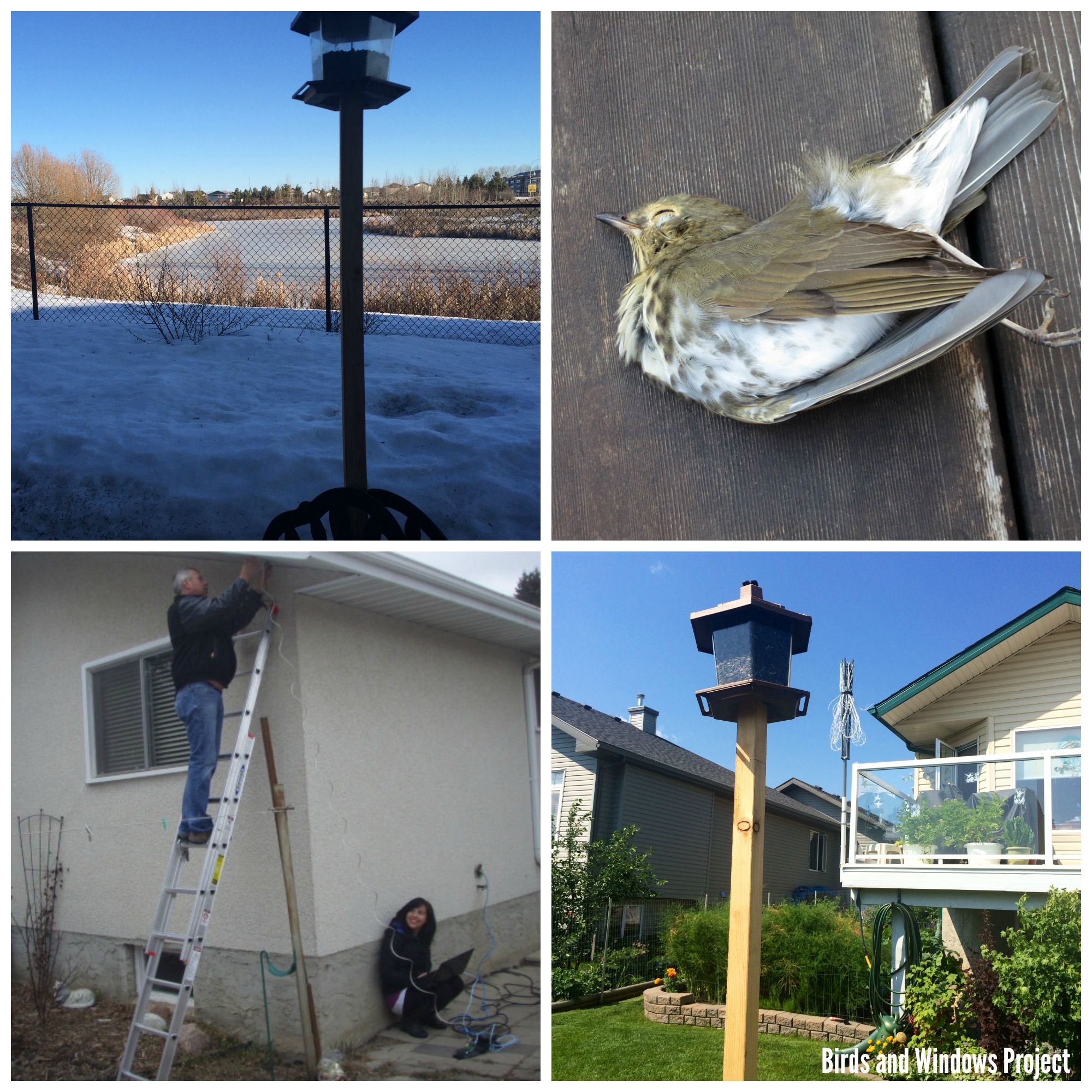
Literature Cited
Bayne, E. M., C. A. Scobie, and M. Rawson-Clark. 2012. Factors influencing the annual risk of bird-window collisions at residential structures in Alberta, Canada. Wildlife Research 39:583-592.
Klem, D., D. C. Keck, K. L. Marty, A. J. M. Ball, E. E. Niciu, and C. T. Platt. 2004. Effects of window angling, feeder placement, and scavengers on avian mortality at plate glass. Wilson Bulletin 116: 69-73.
Kummer, J. and Bayne, E. 2015. Bird feeders and their effect on bird-window collisions at residential houses. (submitted to Avian Conservation and Ecology)
Machtans, C. S., C. H. R. Wedeles, and E. M. Bayne. 2013. A first estimate for Canada of the number of birds killed by colliding with building windows. Avian Conservation and Ecology 8:90-104.

